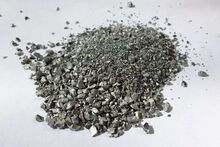Chemistry:Devarda's alloy

| |
| Identifiers | |
|---|---|
| ChemSpider |
|
PubChem CID
|
|
| UNII | |
| Properties | |
| Density | 5.79 g/cm3 |
| Melting point | 490 to 560 °C (914 to 1,040 °F; 763 to 833 K)[1] |
| Boiling point | 906 °C (1,663 °F; 1,179 K) |
| insoluble | |
| Hazards | |
| GHS pictograms | 
|
| GHS Signal word | Warning |
| H228 | |
| P210, P240, P241, P280, P378 | |
Except where otherwise noted, data are given for materials in their standard state (at 25 °C [77 °F], 100 kPa). | |
| Infobox references | |
Devarda's alloy (CAS # 8049-11-4) is an alloy of aluminium (44% – 46%), copper (49% – 51%) and zinc (4% – 6%).
Devarda's alloy is used as reducing agent in analytical chemistry for the determination of nitrates after their reduction to ammonia under alkaline conditions. It is named for Italian chemist Arturo Devarda (1859–1944), who synthesised it at the end of the 19th century to develop a new method to analyze nitrate in Chile saltpeter.[2][3][4]
It was often used in the quantitative or qualitative analysis of nitrates in agriculture and soil science before the development of ion chromatography, the predominant analysis method largely adopted worldwide today.[5] [6]
General mechanism
When a solution of nitrate ions is mixed with aqueous sodium hydroxide, adding Devarda's alloy and heating the mixture gently, liberates ammonia gas. After conversion under the form of ammonia, the total nitrogen is then determined by Kjeldahl method.[7]
The reduction of nitrate by the Devarda's alloy is given by the following equation:
- 3 NO−3 + 8 Al + 5 OH− + 18 H2O → 3 NH3 + 8 [Al(OH)4]−
Distinction between NO3− and NO2− with spot tests
To distinguish between nitrate and nitrite, dilute HCl must be added to the nitrate. The brown ring test can also be used.
Similarity with the Marsh test
Devarda's alloy is a reducing agent that was commonly used in wet analytical chemistry to produce so-called nascent hydrogen under alkaline conditions in situ. In the Marsh test, used for arsenic determination, hydrogen is generated by contacting zinc powder with hydrochloric acid. So, hydrogen can be conveniently produced at low or high pH, according to the volatility of the species to be detected. Acid conditions in the Marsh test promote the fast escape of the arsine gas (AsH3), while in hyperalkaline solution, the degassing of the reduced ammonia (NH3) is greatly facilitated.
Long-debated question of the nascent hydrogen
Since the mid-19th century the existence of true nascent hydrogen has repeatedly been challenged. It was assumed by the supporters of this theory that, before two hydrogen atoms can recombine into a more stable H2 molecule, the labile H· free radicals are more reactive than molecular H2, a relatively weak reductant in the absence of a metal catalyst. Nascent hydrogen was supposed to be responsible for the reduction of arsenate or nitrate in arsine or ammonia respectively. Nowadays, isotopic evidence[8] has closed the nascent hydrogen debate, presently considered to be a Gedanken artifact of romanticism.[9][10][11]
See also
- Kjeldahl method
- Nitrate test
- Nitrite test
- Nascent hydrogen
- Marsh test
- Detection of:
- Raney nickel, prepared from an Al, Ni alloy also dissolved in concentrated NaOH
- Zinc-copper couple
References
- ↑ "SICHERHEITSDATENBLATT". http://www.merckmillipore.com/INTERSHOP/web/WFS/Merck-DE-Site/de_DE/-/EUR/ShowDocument-File?ProductSKU=MDA_CHEM-105341&DocumentId=105341_SDS_DE_DE.PDF&DocumentType=MSD&Language=DE&Country=DE.
- ↑ Devarda, A. (1892). "Ueber die direkte bestimmung des stickstoffs im salpeter". Chemiker Zeitung 16: 1952.
- ↑ Devarda, A. (1894). "Eine neue methode zur bestimmung des stickstoffs im chilisalpeter". Analytical and Bioanalytical Chemistry 33 (1): 113–114. doi:10.1007/bf01335775. https://zenodo.org/record/1428194.
- ↑ Devarda, A.; J. Fields (1899). "Ueber stickstoffbestimmung". Analytical and Bioanalytical Chemistry 38 (1): 55–57. doi:10.1007/bf01386922. https://zenodo.org/record/1447427.
- ↑ Feigl, Fritz (1961). "Spot tests based on redox reactions with Devarda's alloy and Raney alloy". Analytical Chemistry 33 (8): 1118–1121. doi:10.1021/ac60176a018.
- ↑ O'Deen, William A.; Lynn K. Porter (1980). "Devarda's alloy reduction of nitrate and tube diffusion of the reduced nitrogen for indophenol ammonium and nitrogen-15 determinations". Analytical Chemistry 52 (7): 1164–1166. doi:10.1021/ac50057a044.
- ↑ Liao, Christina F.H. (1981). "Devarda's alloy method for total nitrogen determination". Soil Science Society of America Journal 45 (5): 852–855. doi:10.2136/sssaj1981.03615995004500050005x. Bibcode: 1981SSASJ..45..852L.
- ↑ Laborda, F.; Bolea, E.; Baranguan, M. T.; Castillo, J. R. (2002). "Hydride generation in analytical chemistry and nascent hydrogen: when is it going to be over?". Spectrochimica Acta Part B: Atomic Spectroscopy 57 (4): 797–802. doi:10.1016/S0584-8547(02)00010-1. ISSN 0584-8547. Bibcode: 2002AcSpe..57..797L.
- ↑ Tommasi, D. (1897). "Comment on the Note of R. Franchot entitled "Nascent Hydrogen"". The Journal of Physical Chemistry 1 (9): 555. doi:10.1021/j150591a004. ISSN 1618-2642. https://zenodo.org/record/1428786.
- ↑ Meija, Juris; D’Ulivo, Alessandro (2008). "Nascent hydrogen challenge". Analytical and Bioanalytical Chemistry 391 (5): 1475–6. doi:10.1007/s00216-008-2143-4. ISSN 1618-2642. PMID 18488209.
- ↑ Meija, Juris; D’Ulivo, Alessandro (2008). "Solution to nascent hydrogen challenge". Analytical and Bioanalytical Chemistry 392 (5): 771–772. doi:10.1007/s00216-008-2356-6. ISSN 1618-2642. PMID 18795271.
External links
- Devarda's alloy - Substance Summary (SID 24856330) (PubChem Substance)
- Safety data for Devarda's alloy
- Sigma Aldrich: Devarda’s alloy purum, for preparative purposes, grit
- GFS Chemicals: Devarda's alloy, reagent (ACS)
- National Pollutant Inventory - Copper and compounds fact sheet
Further reading
- Cahen, Edward (1910). "A comparison of Pozzi-Escot's and Devarda's method for the estimation of nitrates". The Analyst 35 (412): 307–308. doi:10.1039/AN9103500307. Bibcode: 1910Ana....35..307C.
- Kieselbach, Richard (1944). "Microdetermination of nitrates by Devarda method". Industrial & Engineering Chemistry Analytical Edition 16 (12): 764–766. doi:10.1021/i560136a017.
 |

